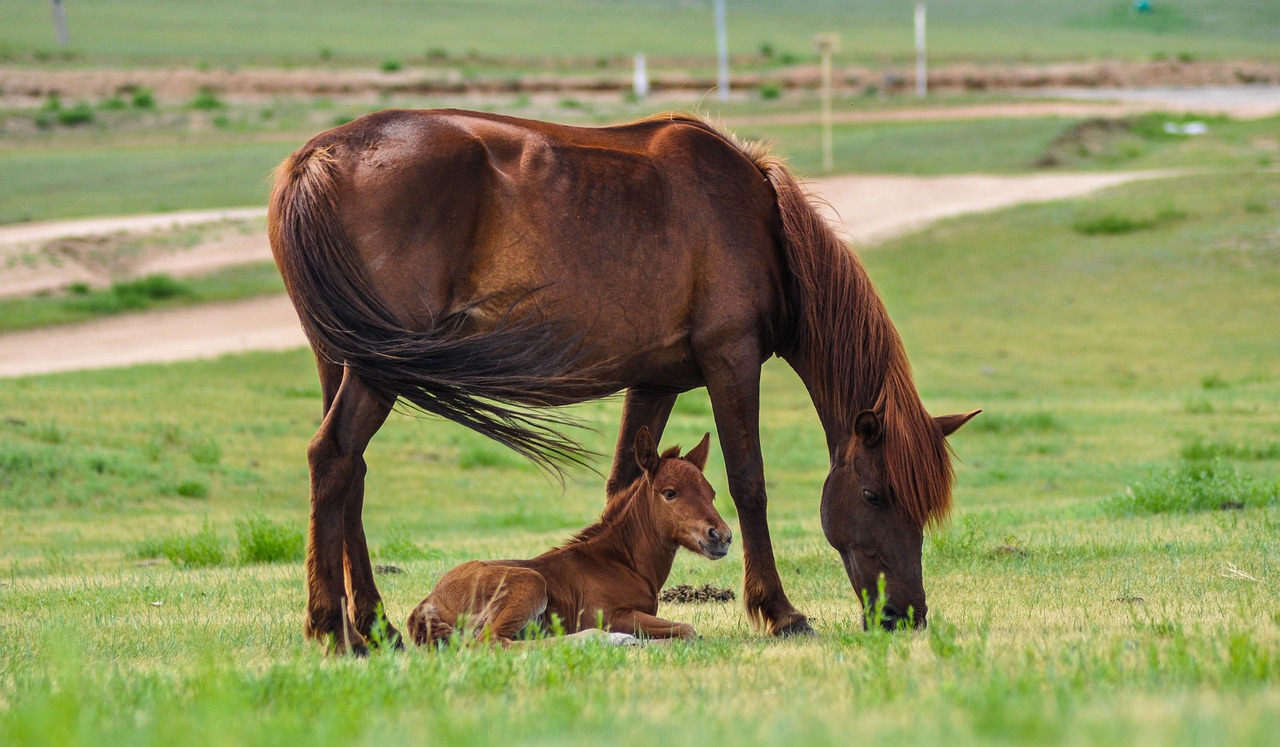Mares
As a general recommendation mares should be wormed throughout the gestation period with a final treatment being given 2-4weeks prior to foaling. You can use Equest or Equest Pramox. On the day of foaling belt and braces would be to give a dose of Ivermectin to knock out the threat from threadworm that pass to the foal in the mares milk.
Foals
The first parasite that can affect foals from an earlier age are Intestinal Threadworms (Strongyloides westeri) In foals this can cause diarrhoea, weakness, weight loss and poor growth. Infected mares pass the worm in their milk onto their young foals. If this infection is suspected there are wormers that can be used from 2 weeks of age.
Youngsters and foals are prone to Ascarids (Roundworm) for the early part of their life usually developing an immunity at 18 months. Ascarids prey on the naïve immune systems of horses less than 18 months old and can cause depression, respiratory disease, stunted growth, diarrhoea, constipation and potentially fatal colic.
Immature ascarid larvae migrate through the foal’s lungs and liver. Heavy burdens of adult roundworms can cause a life-threatening impaction in the foal’s small intestines.
As the foal gets older and grazes more, the risk of other parasites such as the small redworm (Cyathastomins) and the large redworm (Strongylus vulgaris), and tapeworm take over. (Tapeworm infestation is unlikely in foals under two months of age.) If the foal is grazing with several other horses then a first tapeworm test should be given at 4 months old using the Equisal saliva test. If tapeworm is present they can be dosed using either a double dose of pyrantel (Strongid P) or a single dose of praziquantel (either Equimax or Equest).
Worming regime for Foals
As a general guide foals should be wormed as soon as they start to graze pastures or pick at the mares droppings with reference being made to the suitability for foals with regard to each product used. Again the worming intervals for foal worming depend on which product is selected but with foals the manufacture recommended interval will act as good guide.
Foals can be given the following:
Panacur
Equimax (from two weeks)
Strongid-P (from four weeks)
Noromectin (from six weeks)
Equest (from four months)
Pramox (from six and half months)
Once the risk factors and conditions has been taken into consideration (See below) you can then decide when to start a worming regime for foals with 4-8 weeks been used as a general guide. With regard to the general treatment of foals and young stock and as to how often wormers are given the management and circumstances must be again taken into account and most importantly the recommended dosing interval relevant to the product chosen. Use biannual faecal egg counts in weanlings and yearlings to evaluate the efficacy of your parasite control program. Discuss these results with your SQP.
One regime would be to treat foals using a pyrantel based product at 1 month of age then monthly until an ivermectin based product at 5 months of age and a double dose of a pyrantel based product at 6 months of age before slotting them into an adult based program. As a guide to dosages a 4 month old thoroughbred will weigh about 180kg whereas a new born will be about 50kg. At 6 months the weight will be between 200 and 230kg
From 6 months of age test every 6-8 weeks until a yearling only worming if needed. Continue testing the mare at three monthly intervals. Either blood test or worm both mare and foal for the possibility of encysted redworm in winter. Small redworms are one of the most common and harmful parasites found in horses. They are at their most dangerous in their larval stages when they burrow into the lining of the gut and encyst. In this stage they don’t lay eggs and so their presence can’t be detected by a worm egg count. Untreated these encysted small redworm pose a potentially fatal health risk to horses as they can emerge en-masse from the gut wall in spring, causing loss of condition, digestive upsets and colic. Use Panacur 5 day Guard for lean youngsters or Equest if they have a good covering of body fat.
Young Horses
If possible try to graze young horses separately from older horses as the young horses are likely to have the highest worm burden and therefore will cause the majority of pasture contamination. Younger horses need to be wormed more regularly than their older stable mates. Tapeworm burden generally is worse in young horses between the ages of 6 months to 2 years with the years of 3 to 15 having much lower infestations and levels rising again in veteran horses. This situation is very much the same with regard to roundworms and recent studies have shown that where there is a roundworm infestation then there is a strong likely hood of a a tapeworm infestation too. If possible it is a good idea to avoid putting youngstock on the pastures that have been grazed by last years foals.
Circumstances which could put young stock at high risk are:
Repeated use each year of the same pasture for each year’s new foals
Sharing the grazing with other youngsters or foals.
General overstocking of the available grazing.
A previously poor worming regime or testing on the mares
Circumstances which may mean the foals are at a lower risk are:
Dung removal carried out on regular basis.
Resting pastures for lengthy periods ideally 12 months or as much as possible during the months when demands on pastures are less high.
Using pastures that did not have foals on in the previous year.
Not grazing foals with other youngsters.

